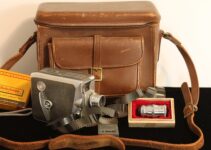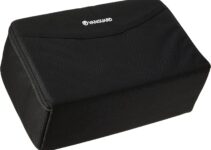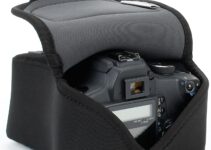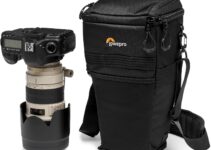When embarking on a hiking trip, ensuring that your camera gear is properly packed and protected is crucial for capturing those breathtaking moments along the way.
This guide will provide you with essential tips and considerations on how to efficiently pack your camera bag, keeping your equipment safe and easily accessible throughout your adventure.
Here you go. Here check out how to use an Amazon camera bag.
How to pack a camera bag for hiking trip?
Here are the steps for packing a camera bag for a hiking trip, including the order in which to pack your items:
1. Start with the essentials:
Place your camera body in a padded compartment or wrap it in a protective case. Make sure it is easily accessible when needed.

2. Add your primary lens:
Place your main lens next to the camera body, preferably with the lens hood attached. This ensures your most frequently used lens is readily available.
3. Pack additional lenses:
Place any extra lenses you plan to bring in separate padded compartments or lens cases. Stack them vertically to save space and provide additional protection. Here loo up how big waterproof camera bag your use.
4. Secure small accessories:
Place smaller camera accessories such as memory cards, spare batteries, lens filters, and remote shutter releases in designated pockets or compartments within the bag.
These smaller items are less likely to cause damage to your camera gear if packed securely.
5. Include a tripod:
If you’re bringing a tripod, secure it to the outside or bottom of the camera bag using the designated straps or holders. Ensure it is properly fastened and doesn’t hinder your movement while hiking.
6. Organize cables and chargers:
Coil up any necessary cables, such as USB or charging cables, and place them in a separate compartment or a small pouch within the bag. Keeping them organized prevents tangling and makes them easily accessible.
7. Consider additional accessories:
If you have space, add any other accessories such as lens cleaning kits, lens cloths, lens pens, or flash units in dedicated pockets or compartments. Ensure these items are securely stored to avoid damage. Here look up how to organize canon camera bag?
8. Pack personal items:
If your camera bag has additional compartments or pockets, you can use them to store personal items like snacks, a water bottle, a light rain jacket, or a small first aid kit. Just make sure these items won’t cause any damage to your camera gear.
9. Close and secure the bag:
Once everything is packed, close all zippers, fasteners, and straps on your camera bag.
Give it a gentle shake to ensure nothing moves or rattles around. This helps prevent any accidental damage to your equipment during the hike.

Remember, the packing order can vary depending on your specific camera bag and gear. It’s essential to choose a bag that suits your needs and offers appropriate compartments and padding to keep your gear safe.
14 Proven steps to pack a camera bag for hiking trip
Choosing the Right Camera Bag
Selecting the right camera bag for your hiking trip is the foundation of successful gear organization.
Look for a bag that is specifically designed for outdoor activities, providing sufficient padding, compartments, and weather-resistant materials.
Opt for a backpack-style bag that evenly distributes weight across your shoulders and back for better comfort during long hikes.
Organizing Your Gear
Before packing your camera bag, take some time to organize your gear.
Create a checklist of the essential equipment you plan to bring, including your camera body, lenses, filters, and other accessories.
Categorize them based on frequency of use and prioritize the items you expect to reach for most often.
Protecting Your Equipment
Your camera gear is delicate and requires proper protection.
Invest in protective cases, lens pouches, and camera wraps to shield your equipment from impact, moisture, and dust. Consider using silica gel packets to prevent condensation inside the bag.
Managing Weight and Space
Hiking trips often involve long walks and steep ascents, so managing the weight and space in your camera bag is important.
Choose lightweight gear whenever possible and avoid carrying unnecessary items. Maximize the available space by utilizing packing cubes or padded dividers to create customized compartments. Here look up how to store your camera in bag?
Ensuring Accessibility
When capturing stunning moments in nature, accessibility is key. Arrange your gear so you can quickly and easily access the equipment you need without fumbling around.
Place frequently used items in the most accessible compartments or pockets of your camera bag.
Carrying Extra Batteries and Memory Cards
Hiking trips can last for extended periods, so carrying extra batteries and memory cards is essential.

Make sure to fully charge your batteries before leaving and bring additional ones as backups.
Similarly, have sufficient memory cards to accommodate the number of photos you plan to take.
Packing a Tripod
A tripod can greatly enhance your photography experience during a hiking trip.
Look for lightweight and compact tripod options that fit well within your camera bag.
Consider tripod alternatives like mini tripods or flexible tripods for added versatility and convenience.
Weatherproofing Your Camera Bag
Nature is unpredictable, and weather conditions can change rapidly during a hike.
Ensure your camera bag is weatherproof by using rain covers or dry bags to protect your equipment from rain, snow, and dust.
This extra layer of protection will give you peace of mind and allow you to focus on capturing amazing shots.
Keeping Your Bag Comfortable
Since you’ll be carrying your camera bag for extended periods, comfort is crucial.
Look for bags with adjustable shoulder straps, waist belts, and back padding to provide ergonomic support.
Adjust the straps to distribute the weight evenly across your body, reducing strain on your back and shoulders.
Distributing Weight Properly
To prevent discomfort and fatigue, it’s important to distribute the weight of your camera bag properly.
Place heavier gear closer to your back and lighter items towards the outer compartments. This distribution will maintain balance and stability while hiking, reducing strain on your body. Here check out how to organize your camera bag?
Taking Care of Your Camera Bag
Maintaining your camera bag’s longevity is essential. Regularly clean your bag to remove dirt and debris that might damage your equipment.
Follow the manufacturer’s instructions for cleaning and storage, and avoid exposing your bag to extreme temperatures or prolonged sunlight.
Staying Prepared for Changing Conditions
Hiking trips often involve varying weather conditions and terrains.
Pack versatile clothing and gear to adapt to changing environments. Consider carrying a lens cloth, lens filters, and a camera rain cover to protect your gear during sudden weather shifts.
Securing Your Bag
While hiking, you need to ensure the safety of your camera bag. Opt for a bag with sturdy zippers and additional security features like locks or buckles.

Stay vigilant and keep your bag within sight or use a carabiner to secure it to your backpack.
Quick Tips for Efficient Packing
- Roll clothing items to save space and prevent wrinkles.
- Use cable organizers to manage cords and cables.
- Place smaller accessories in ziplock bags for easy organization.
- Utilize empty spaces, such as shoes, for storing smaller gear items.
FAQs
Can I use a regular backpack instead of a camera bag for hiking trips?
While a regular backpack may offer some storage options, a dedicated camera bag provides better protection and organization specifically tailored for camera equipment.
How many lenses should I bring on a hiking trip?
The number of lenses depends on your personal preference and the specific requirements of your photography. Consider the weight and versatility of each lens before deciding.
Are there any specific camera bag brands recommended for hiking trips?
Several reputable brands are known for producing high-quality camera bags suitable for hiking, including Lowepro, MindShift Gear, and Peak Design. Research different options to find the one that best suits your needs.
Should I pack extra camera accessories like filters and lens hoods?
Including extra camera accessories like filters and lens hoods can be beneficial as they offer creative possibilities and added protection for your lenses.
Is it necessary to remove the camera strap when packing the camera in the bag?
It is not necessary to remove the camera strap, but make sure to securely store and organize it within the bag to avoid any tangling or damage.
How do you carry your camera when hiking?
When hiking, there are several ways to carry your camera for easy access and protection. Consider using a camera backpack with dedicated compartments and padded inserts to secure your gear.
Alternatively, a cross-body sling or waist pack can provide quick access to your camera while keeping your hands free for hiking.
How do you pack a camera when backpacking?
When backpacking, it’s important to pack your camera securely to protect it from the elements and potential damage.
Place your camera and lenses in a padded camera insert or wrap them in soft clothing for extra cushioning. Store them in the center of your backpack to minimize impact and consider using a waterproof cover for added protection
How do you attach a camera to a hiking bag?
Attaching a camera to a hiking bag can be done using various methods. One option is to use a camera clip or mount that attaches securely to the shoulder strap or hip belt of your backpack.
Another option is to use a carabiner or strap to secure the camera to a loop or D-ring on the bag. Ensure the attachment is secure and easily accessible for quick camera access during your hike..
How do you pack a camera for travel?
When packing a camera for travel, start by removing any lenses and accessories. Place the camera body and lenses in a padded camera bag or wrap them in soft clothing for protection.
Pack them in the center of your suitcase, surrounded by clothes or other soft items to cushion against any potential impact.
Conclusion
When embarking on a hiking trip, properly packing your camera bag is essential for capturing memorable moments in nature.
By following the tips provided in this article, you can ensure that your camera gear remains safe, accessible, and protected throughout your adventure.
Remember to choose the right camera bag, organize your gear effectively, protect your equipment, and distribute weight properly.
With careful planning and preparation, you’ll be ready to capture stunning photographs during your hiking journey.







